A small vegetable garden can provide homeowners with fresh, healthful food, assist household finances during a time of increasing food costs, and provide a family activity that is both recreational and educational (Figure 1).
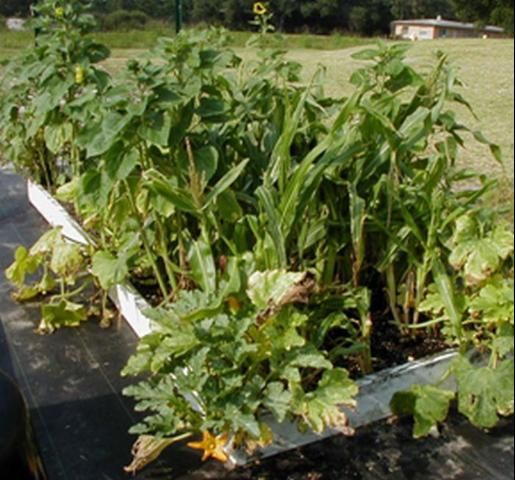
Credit: E. Thralls
A bountiful harvest from a small garden depends on many factors. One factor to consider is the successful pollination needed for fruit set on certain vegetable crops, including cantaloupe, cucumbers, squash, and watermelon.
In a small garden space, one located in a residential landscape setting, there may not be an established population of insects necessary for pollination. As a result, pollination can be sporadic, and yield may be meager to nonexistent. However, it is possible to pollinate some of the most popular vegetable crops by hand. For more information, please refer to EDIS publication RF-AA091, Beekeeping: Watermelon Pollination, https://edis.ifas.ufl.edu/publication/AA091, and EDIS publication HS-675, Squash, Zucchini—Cucurbita pepo L, https://edis.ifas.ufl.edu/publication/MV142.
The EDIS publication you are reading now addresses techniques for hand pollination of squash and corn. Yellow crookneck squash and zucchini squash are among the most popular crops for home vegetable gardeners. These crops thrive in summer heat and can produce a bounty of vegetables up to the first killing frost. However, these crops also depend on bees to carry pollen. By contrast, crops of corn depend on wind to carry pollen from the tassels to the silks. Even in large, commercial operations, corn stalks along the edges of a field may not receive sufficient amounts of pollen to produce strong yields. Knowing the basics of flower structure and the steps to cross-fertilization can help ensure a good harvest.
Techniques for Hand Pollinating Squashes
All squashes are members of the plant family Cucurbitaceae. This family, commonly called the Gourd Family, includes more than 700 species of fast-growing, cold-tender plants throughout the world. Well known members of this plant family include pumpkins, squash, cucumbers, and melons. For more information, refer to Manual of Cultivated Plants by L.H. Bailey.
All squash have male flowers and female flowers (Figure 2) on the same vine or bush. The ratio of males to females varies with the type of squash. The first step is to identify male and female flower structure because only the female flowers bear fruit (Figure 3). Males have a plain stem beneath their flower. Peeling the petals back reveals the male anther. Bright orange-yellow pollen grains will rub off on contact. They do not transfer by wind. These grains of pollen need to be transferred to the female by direct touch.
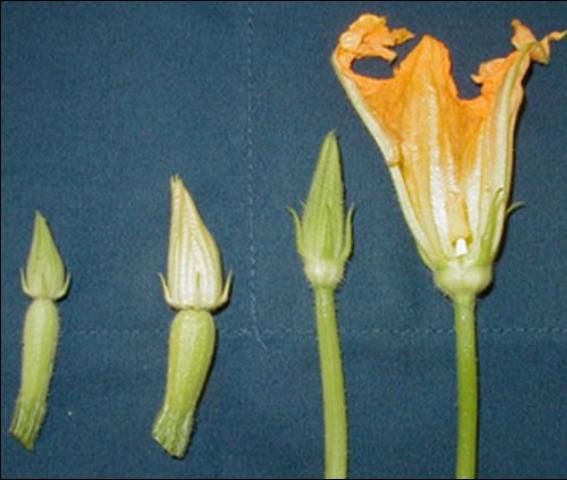
Credit: E. Thralls
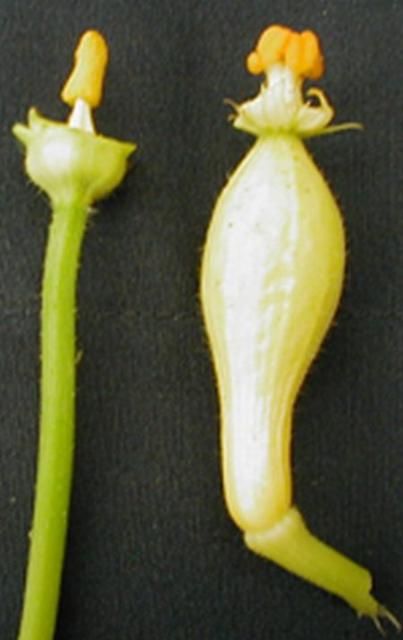
Credit: E. Thralls
The female flowers exhibit the form of a rudimentary squash just below their petals. Peel these petals off, and you will see the "stigma," a raised, yellow-orange structure in the center. Apply the pollen to the stigma by touching the male anther to the female stigma (Figure 4) or by using a paint brush; pick up pollen on the brush from the anther and "paint" the stigma with pollen. You have just accomplished pollination.
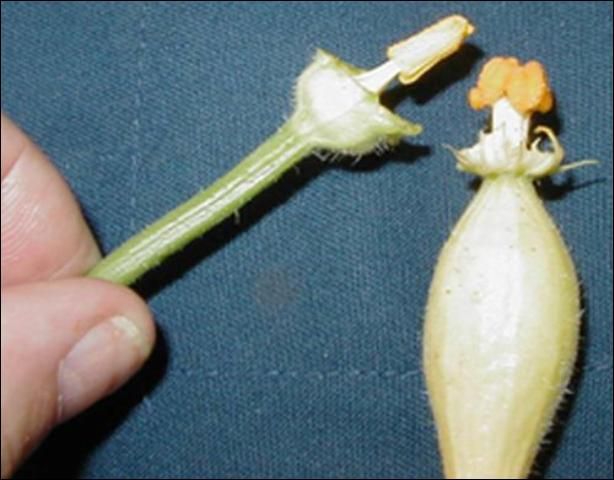
Credit: E. Thralls
Gardeners frequently note that their squash blooms profusely, yet fruit does not develop as they expect. The plants may produce only male flowers or only female flowers. Flower sex is influenced by temperature, seasonal day length, plant maturity and hormones. For more information, refer to Wyman's Gardening Encyclopedia by Donald Wyman.
Both male and female flowers are open in the morning and are ready for pollination to occur, and then they close up by evening. Pollination is best done in the morning, when high humidity helps to activate the pollen. One male flower can be used to pollinate several female flowers. Male flowers can be cut, like a cut flower, and held in water over night (Figure 5) to pollinate available female flowers the next morning. Male flowers may also be stored by laying them on moist paper towels in a storage container in a refrigerator for three to four days. When storing male flowers in a refrigerator, remove the petals by hand or with scissors. Be sure to prevent the pollen from directly contacting the moist paper towel.
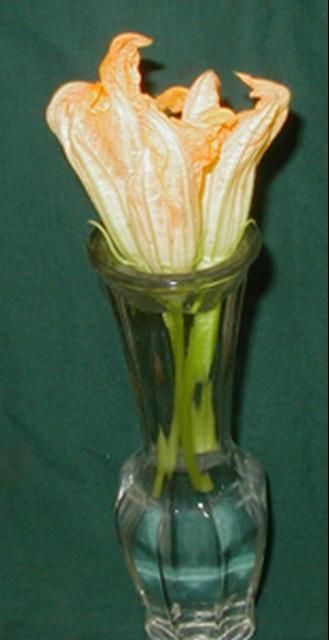
Credit: E. Thralls
Hand pollination ensures varietal consistency in the next generation of squash plants. Gardeners who save their seeds for the next crop need to be aware that pumpkins, squash and gourds will cross-pollinate. While the fruit is edible and delicious, the seed from such a cross, if saved and replanted, will not grow to look or taste true to the parent plant. Therefore, some separation in the garden to prevent cross pollination may be necessary for those gardeners who save their seeds for the next crop of straight necks, crooknecks, spaghetti squash, pumpkins and others. For more information, refer to Wyman's Gardening Encyclopedia, p. 1064.
Techniques for Hand Pollinating Corn
Corn is in the plant family Gramineae, the annual grasses. Countless varieties of corn are available for planting, and selections are adapted for a wide variety of soils and climate conditions. For more information, refer to EDIS Publication HS737, Sweet Corn Production in Florida, https://edis.ifas.ufl.edu/publication/CV135.
Corn (Zea mays) is one of the most important food crops in the United States and is a staple of backyard home gardens. This crop does not exhibit flowers with showy petals, but it does have male flowers and female flowers on each plant. The male flowers are located at the top of the stalk and are borne in a branched floral structure, called the tassel (Figure 6). Similar to the squash male flower, you can run your fingers over the corn anthers and observe resulting smudges of pale yellow pollen. The pollen grains of corn are small and fine and are usually transferred by wind dispersal.

Credit: E. Thralls, UF/IFAS
The female part of corn is the ears, which are edible. The ears are located lower on the stalks, just above the leaves, at the nodes. One to four ears per stalk is typical, depending on variety. The female flowers are the "silk" (Figure 6). The silk is the same stigma as in squash, but the stigma in corn is elongated. Each strand of silk corresponds to one kernel of corn. Pollination is achieved when pollen grains from the tassels above contact the silks at the nodes.
Two methods of pollen transfer may be used with corn. Cut an entire tassel, and use it as a wand, shaking pollen grains (dust) onto the silks. Alternatively, strip the tassel and deposit the pollen from the anthers directly onto the silks. Either way, the pollen is transferred. Be thorough when dusting the pollen onto the silks, so chances for a bountiful harvest are increased.
References
Bailey, L.H. 1971. Manual of Cultivated Plants. Macmillan and Company New York.
Sanford, Malcolm T. 1992. Beekeeping: Watermelon Pollination. https://edis.ifas.ufl.edu/publication/AA091
Simonne, E.H., W.M. Stall, S.M. Olson, S.E. Webb, T.G. Taylor, S.A. Smith, R.N. Raid. 2007. Sweet Corn Production in Florida. https://edis.ifas.ufl.edu/publication/CV135
Stephens, James M. 1994. Squash, Zucchini—Cucurbita pepo L. https://edis.ifas.ufl.edu/publication/MV142
Wyman, Donald. 1987. Wyman's Gardening Encyclopedia, Second Edition. The Macmillan Company, New York.